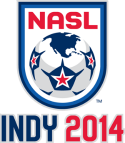The new North American Soccer League (NASL) was officially founded in November 2009 when a group of 2nd division men’s professional soccer team owners banded together to form North American Soccer League, LLC for the purpose of creating a team-owned and operated professional soccer league in the United States, Canada and Puerto Rico. In February 2011, the NASL received provisional recognition from the United States Soccer Federation as the exclusive second division men’s professional league (D-2) and the inaugural season kicked off on the evening of April 9, 2011, with games in Cary, North Carolina; Atlanta, Georgia; Fort Lauderdale, Florida; and St. Petersburg, Florida. The Carolina RailHawks finished first in the standings, and the Minnesota Stars were crowned the inaugural NASL Champions
On April 7, 2012, the league’s second campaign was underway. Expansion side San Antonio Scorpions, led by NASL Golden Ball and Golden Boot winner Pablo Campos, were named Regular Season Champions in their debut season. The Tampa Bay Rowdies became the second side to become NASL Champions, by defeating the defending champions Minnesota Stars FC in a penalty kick shootout in the NASL Championship Series.
The NASL member teams are: Atlanta Silverbacks, Carolina RailHawks, FC Edmonton, Fort Lauderdale Strikers, Minnesota Stars FC, Puerto Rico Islanders, San Antonio Scorpions (replacing Montréal Impact) and Tampa Bay Rowdies. The Montréal Impact were admitted to Major League Soccer (MLS) beginning with the 2012 season. On June 20, 2011, the NASL announced its expansion into Ottawa, Ontario, pending the completion of renovations to Lansdowne Park. On July 12, 2012 the New York Cosmos joined the NASL, to begin play in the 2013 season and on November 5, 2012 Virginia was admitted as an NASL team for the 2014 season. The NASL received official Division 2 sanctioning from the USSF on March 2, 2012. The vote of the national council was unanimous.
Each of the NASL teams play their home games in stadiums (with capacities ranging from approximately 5,000 to 15,000) that allow fans to experience the games in a uniquely intimate setting. The NASL operates on traditional business practices employed by most of the major national soccer leagues throughout the world. Each team within the league is responsible for its own player investment and development, and is free to scout, trial, sign and transfer players as it wishes in the best interest of the individual team. While there are limits to the size of the active rosters for each team (30) and the number of foreign players permitted per team (7), the league does not impose a salary cap on its members. Approximately 200 soccer players are currently on the NASL’s team rosters, and their backgrounds as players are as diverse as their nationalities. On opening day of the 2011 season, the youngest player in the league was 18 and the oldest was 39. Several have experience playing in Europe and Latin America’s first divisions, as well as at the national team level, while others have MLS experience here in North America. Yet many NASL players are in the early stages of their professional careers, and using the league as a stepping stone to higher professional leagues.
While the clear majority of the players hail from the U.S. or Canada, 30 other nationalities were represented on 2012 opening day rosters. Although the NASL shares its name with the league that operated throughout North America during the period of 1968-1984, there is no official tie to the business structure of the now-defunct NASL. However, with six of the new NASL teams operating in cities with a rich memory of past glory of the former NASL there is more than a hint of the former NASL’s heritage to be found in the new NASL of today. Three examples being the Joma match ball whose design was inspired by the ball in play some 40 years ago, and the Fort Lauderdale Strikers and Tampa Bay Rowdies franchises whose names and jerseys are virtually identical to those of the teams that graced the pitch in the late 1970’s and early 1980’s and featured George Best, Rodney Marsh, Nene Cubillas and Gerd Müller, among others.
The NASL, serving as this region’s second division, does not have a system of relegation and promotion with the officially recognized first (MLS) and third (USL Pro) divisions, nor is there an official working relationship between MLS and NASL. However, in addition to the Montréal Impact, a number of recent second division men’s professional clubs have gone on to compete in MLS after successfully building a team and fan base at the NASL level. The current MLS clubs Seattle Sounders, Portland Timbers, Vancouver Whitecaps and now Montréal Impact all played D-2 soccer prior to entry into MLS. Player movement between the leagues is facilitated by a strong working relationship at the team levels, and the NASL is also working with MLS at the league level to employ standards designed to foster player health and safety.
